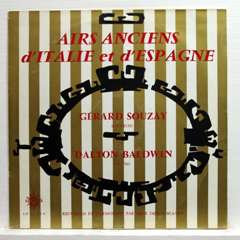Gerard Souzay - Airs anciens d'Italie et d'Espagne (2004)
Gerard Souzay - Airs anciens d'Italie et d'Espagne (2004)

Airs Italiens 01. Francesco Cavalli (1602–1676): Son ancor pargoletta 02. Raffaello Rontani (1580-1622): O primavera 03. Vincenzo Calestani (1589–1617): Accorta lusinghiera 04. Gaetano Brunetti (1744-1798): Deh girate, luci amate 05. Giulio Caccini (1551–1618): Tu ch' hai le penne, amore 06. Piero Strozzi (1550-1609): Spesso per entro al petto 07. Nicola Matteis (1670?-1714?): Caro volto palledetto 08. Giacomo Carissimi (1605-1674): Soccorretemi, ch' io moro 09. Bernardo Pasquini (1637-1710): Quanto è folle 10. Bernardo Pasquini: So ben s' io peno 11. Bernardo Pasquini: Bella bocca Airs Espagnols 12. Alonso Mudarra (c.1510–1580): Triste estaba le Rey David 13. Gabriel (?): A la caza, sus la caza 14. Antonio de Ribera (1480-1522): Por unos puertos arriba 15. Luis de Milán (c.1500–c.1561): Quien amores ten 16. Juan de Anchieta (c.1462-1523): Con amores, la mi madre 17. Francisco de la Torre (floruit 1483–1504): Pampano verde 18. Anonyme: Que bien me lo veo 19. Cristóbal de Morales (c1500-1553): De ante quiera sale el moro 20. Esteve y Grimau (1730-1794): Alma, sintamos Gerard Souzay - baritone Dalton Baldwin - piano Recorded 1958
Mr. Souzay frequently appeared in opera -- including New York City Opera and the Met -- and was widely held to be the definitive Golaud in Debussy's ''Pélléas et Mélisande.'' But it was in art song that he made his greatest mark, and not only in the songs of French composers. His more than 750 recordings include classic versions of Schumann, Schubert and Hugo Wolf.
Although one of his teachers was the great French singer Pierre Bernac, it annoyed him to be called Bernac's worthy successor. He would say, ''I am not like Pierre Bernac, who did not have a proper voice.''
Mr. Souzay certainly did have a proper voice: not huge, but rich in color and tone, supple and sensual and lovely. His reluctance to be stereotyped as merely a French singer was related to the fact that he tended to be eclipsed by his contemporary the German baritone and art-song specialist Dietrich Fischer-Dieskau. Many aficionados have always preferred Souzay. The difference between the two is crudely outlined in the notion that Mr. Fischer-Dieskau specialized in intellectual, text-driven, carefully planned performances, while Mr. Souzay was more of a sensualist, reacting viscerally to the music and allowing it to carry him in new directions in a given concert.
''I think that's the reason why I shall never be really popular,'' he said in 1983. ''The big public likes interpretations that are explanations. For me, music is crystal clear and self-explanatory. Therefore, when I am performing I only propose my feelings.''
Any rivalry between the two, however, was tempered with respect. ''I wish I could sing French song as well as Souzay can sing German lieder,'' Mr. Fischer-Dieskau once said.
Born in December 1918 as Gérard Tisserand, Mr. Souzay studied with Bernac, Claire Croiza and Vanni Marcoux at the Paris Conservatory, from 1940 to 1945. His opera career didn't begin until 1960, when he made his debut in Aix-en-Provence in Purcell's ''Dido and Aeneas,'' but by then he was already well established as a recitalist and recording artist. Famously loyal to his accompanists, he recorded only with two, Jacqueline Bonneau, and Dalton Baldwin, who was still a student when he met Mr. Souzay. The two began a long artistic and personal association.
In later years, Mr. Souzay taught, both at the University of Texas at Austin and in master classes, and seriously took up painting. He also worked on his legacy, supervising the selection and remastering of reissues of his earlier records. His last days, Mr. Ku said, were spent selecting Beethoven songs for a CD.
''Simply, music means a lot to me and I feel very deeply what I sing,'' Mr. Souzay once said. ''Sometimes when I sing I shiver. But it's not because I love what I am doing. It's because music moves me to the bones.'' ---Anne Midgette, nytimes.com
download (mp3 @320 kbs):
uploaded yandex 4shared mega mediafire zalivalka cloudmailru oboom uplea
